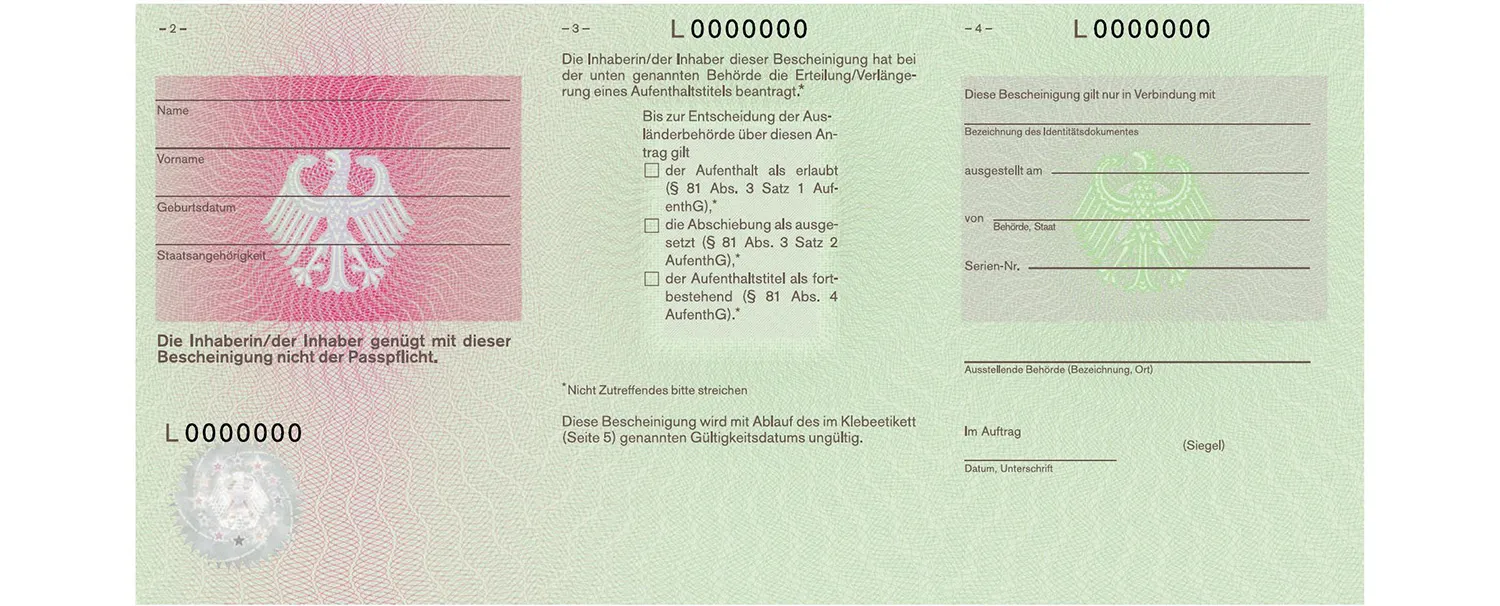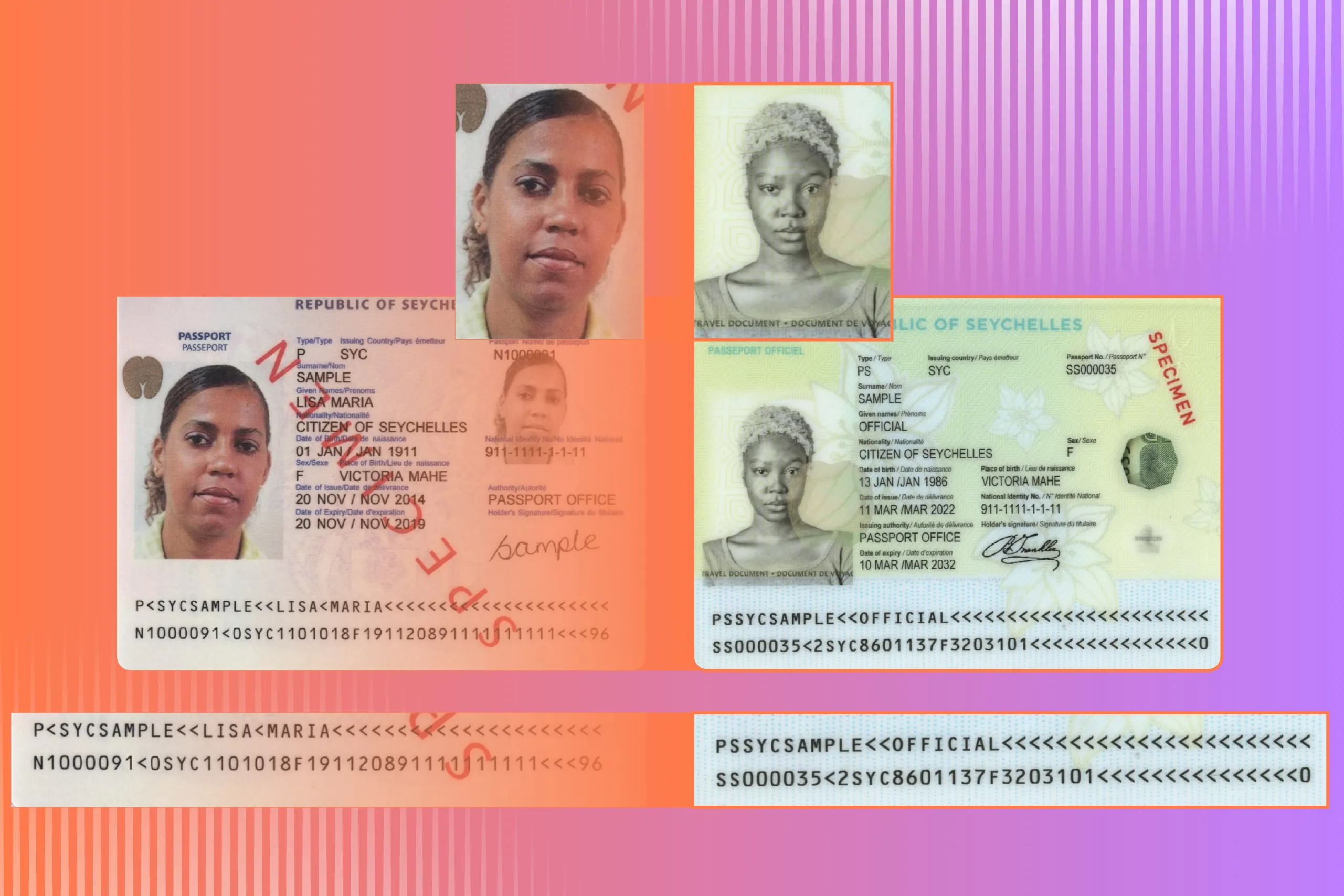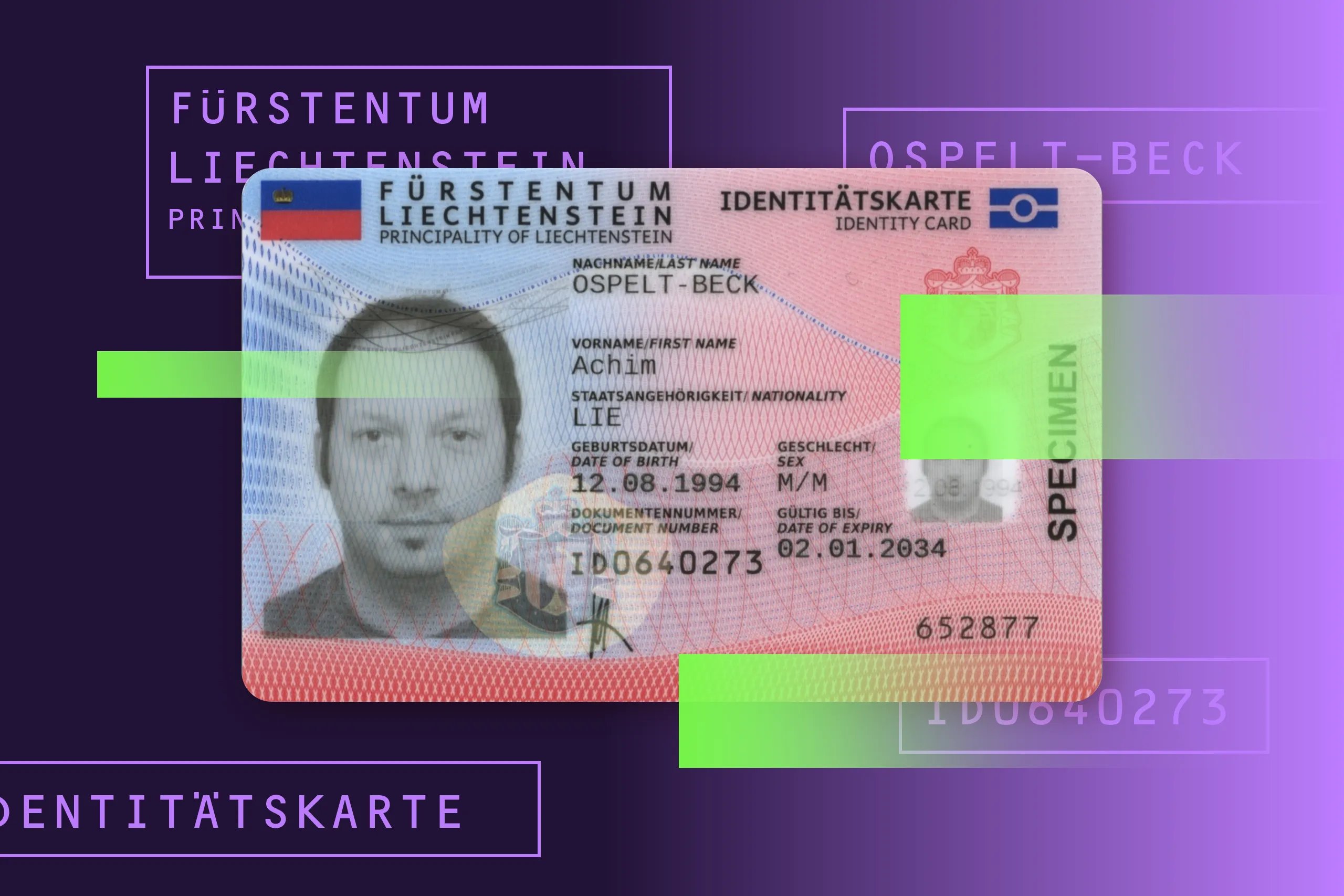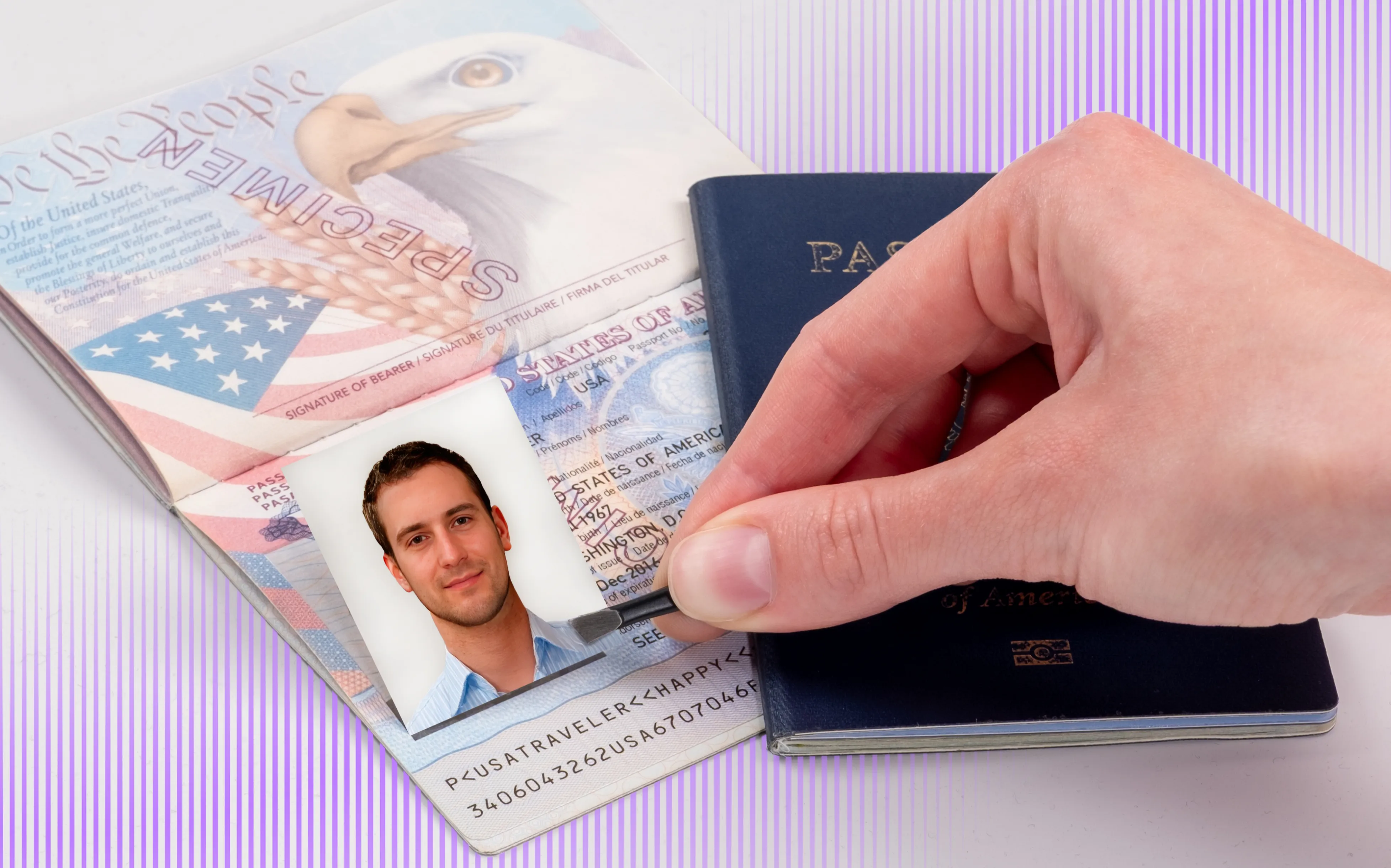Germany stands out as a country that continually updates its passports and ID cards. While many nations revise their documents every ten years, German IDs are refreshed more often, both in design and in security features.
In this article, we explore what makes Germany’s passports, ID cards, and driver’s licenses unique—beyond the wide range of document series currently in circulation.
The challenges of processing German IDs
Like other government-issued documents across the EU, German IDs appear standard and fully ICAO-compliant at first glance. But here, the details make all the difference.
Consider the use of the German language. Although based on the Latin script and seemingly straightforward to process, it includes characters with diacritical marks such as ä, ö, ü, and the special letter ß, which are common in German names.
This poses a challenge for machine-readable zones (MRZs), which must only include standard Latin letters, per ICAO standards. According to Doc 9303, Part 3, there are multiple transliteration options: ä can become AE or A, ö can be OE or O, and so on. As a result, a surname like Müller could appear as either MUELLER or MULLER—even across different documents issued to the same person.
Notably, for naturalized German citizens, even more variations may appear—for instance, letters like å (transliterated as AA) or ø (OE).
While advanced OCR engines can handle these cases through transliteration and by cross-checking visual and MRZ data, it’s a nuance worth mentioning.
Now, let’s take a closer look at currently issued German passports, ID cards, and driver’s licenses.
The German passport: Many series with minor changes
Germany’s 2004 passport series became its first biometric travel documents. However, the electronic chip was only added in 2006. Like other EU countries, Germany’s latest passports follow the standardized burgundy red cover and layout—but that wasn’t always the case.
In the 2004 series, the cover was wider than the inner pages—130x95 mm instead of the ICAO-complaint 125x88 mm. This unusual format forced passport reader providers to treat the German travel document as a unique case during scanning.

There is a curious detail in how the German passport cover has evolved—from the non-standard 2004 series to the current 2024 edition.
The 2004 passport series included one more verification challenge—the main portrait was positioned higher than recommended by ICAO standards for the datapage layout, making the German travel document unique.

The layout in the German 2004 passport was similar to the one used in children's travel documents, which makes it a special case.
These cover and layout inconsistencies were corrected with the 2017 passport update.
Following updates in 2017, 2021, and 2024, three series of German passports are currently in circulation. Despite their similarities, there are major visual (and non-visual) differences between them.

All current German passports feature a polycarbonate data page with consistent personal details.

The ultraviolet (UV) German passport security features are similar, but the documents differ under infrared light.
All three series are processed similarly by identity verification software. The data page contains standard identification information such as the name, date and place of birth. However, page 1 includes additional details that are unusual for passports and can be scanned and verified remotely:
Height
Eye color
Doctorate (if applicable)
Religious name (if applicable)
Domicile

Additional personal information on page 1 (in the 2024 series, shown above) can also be verified remotely.
Page 1 also displays the Card Access Number (CAN), used to access the chip. Germany no longer supports the less secure BAC protocol, instead using PACE, which requires CAN or MRZ fragments. This switch demands support from your IDV solution.
Other machine-readable data includes the passport number and MRZ.
The passport number—for instance, C3JJ4789L—always begins with a letter and consists of digits (1-9) and letters such as C, F, G, H, J, K, L, M, N, P, R, T, V, W, X, Y, Z. The number 0 has not been used since November 1, 2021, and the letter O is typically excluded.
By the way, here’s another curious detail. The 2004 series featured a 10-digit passport number, with the last digit serving as a checksum. This underscores how different this seemingly standard-looking travel document was from expectations.
Interestingly, Germany uses a one-letter country code—D—in the MRZ and visual inspection zone. This is a unique case accepted by all ICAO members, as most countries use the ICAO-recommended three-letter codes in their travel documents.
German passports are valid for ten years for individuals aged 24 and older, and six years for those under 24. Previously, a separate non-biometric document for minors called Kinderreisepass was issued. This was discontinued in 2023.

The Kinderreisepass was abolished in 2023 and is no longer valid for identification.
ID photo requirements in Germany
Starting May 1, 2025, only digital passport photos are accepted. These must be taken at the citizens' office (Bürgerbüro) or by a registered photographer, and submitted digitally. The change aims to prevent photo substitution and face morphing fraud.
Germany also issues a paper-based emergency travel document for foreigners who need to leave or return to the country urgently. It contains standard personal details, such as name, birth date, and nationality, and is valid for a single trip, but no longer than one month. This document can also be scanned and verified remotely.

Germany’s only paper-based ID is the emergency travel document. Some other EU countries, such as Estonia and Latvia, use a similar format for this type of ID.
The German national ID card: Version with an intricate background
German ID cards are optional for citizens who already hold a passport, and can be issued from the age of 16. They also serve as travel documents within the EU and Schengen zone, as well as in countries like Türkiye, Georgia, and Gibraltar. As a result, many German citizens choose to carry one.
Since 2010, German ID cards have been biometric and made of polycarbonate. Interestingly, the initial 2010 version didn’t feature the “chip inside” icon, though it included a six-digit CAN on the front.
That’s because the 2010 ID didn’t сontain the ICAO ePassport application, so there was no need to display the chip icon. By 2021, the application had been added along with the icon itself and the EU flag, in line with EU design standards.
Notably, Germany was also the first to introduce an eID application on the card back in 2010, aiming to support eGovernment services and drive digital transformation for citizens. The idea was ahead of its time, but the rollout of supporting services lagged, and adoption remained relatively slow.

Both the 2010 and 2021 ID card series are currently in circulation.
Unlike German passports, biometric data stored on ID cards (a photo and fingerprints) can only be accessed by authorized authorities like law enforcement and border control.
The printed data is standard: name, date of birth, nationality, and so on. For women, the surname field may include both the current and maiden names. Academic titles like Dr. are also shown next to the surname.
Like in passports, ID cards’ validity depends on the holder’s age—ten years for those aged 24 and older, and six years for those under 24.
The reverse side of the card displays additional information such as height, eye color, and address. Address verification can be challenging: if the holder changes their residence, the card is not reissued. Instead, the new address is added via a sticker secured with an official stamp. This, combined with the ID card’s complex wavy background, makes the field harder to scan and read.

This card features a dynamic security element and a patterned background, both of which can complicate scanning.
German ID cards also include a Multiple Laser Image (MLI), a dynamic security feature used to confirm document liveness. The MLI alternates between the holder’s ghost portrait and the ID’s expiration date. This effect, layered over an intricate background, can be difficult to capture during remote German ID card verification.
Post-quantum cryptography in German ID cards
Germany has announced a transition to quantum-secure ID cards, incorporating advanced cryptographic mechanisms. Specifically, a quantum-resistant digital signature scheme is planned to protect ID cards from forgery in an era when quantum computers could potentially break current encryption methods.
According to the German Federal Office for Information Security (BSI), quantum-secure ID cards are expected to roll out by 2030. This move positions Germany as a pioneer in future-proofing the security of identity documents.

A German quantum-secured identity card may adopt a portrait orientation, as shown by a prototype featured on the Giesecke+Devrient (G+D) website. Currently, Bundesdruckerei GmbH (Federal Printing Office) and G+D have already established a unique technical foundation for the project.
The German driver’s license: An EU-standard, non-biometric document
German driver’s licenses share some similarities with national passports and ID cards. Like them, there are at least two versions currently in circulation, and they follow EU-wide standards for document layout and design. However, unlike passports and ID cards, these licenses are non-biometric, which makes them the least secure for remote verification.
The most widely used series was introduced in 2013. It features the EU flag and a standardized layout, with numbered fields for the holder’s name, date of birth, license expiration date, and vehicle categories.

German driver’s licenses follow a common EU format.
The 2013 version is valid for 15 years and can be issued to individuals aged 15 or older. Importantly, licenses issued before January 19, 2013 had no expiration date and are still valid today—but only until January 19, 2033.

The series issued in 1999-2011 has a slightly different design. The key difference: no expiration date in field 4b.
Although these licenses don’t include a chip, they do contain dynamic security features for verification. The 2013 series, for example, includes an MLI on the reverse. Tools like Regula Document Reader SDK use liveness detection technology to identify this feature and confirm that the document presented online is authentic.
How to effectively process German documents
Given the specific features of German IDs, verification software should support the following capabilities:
Up-to-date template database: Germany frequently updates its passports, ID cards, and driver’s licenses. To ensure accurate verification, your solution must recognize both current and upcoming document templates. For instance, Regula’s database, the largest in the world, includes over 16,000 document templates from 254 countries and territories, with new entries added regularly based on customer requests.
Document liveness checks: Since German ID cards restrict chip access and driver’s licenses are non-biometric, liveness checks are essential. This technology detects dynamic security features—such as MLIs or holograms—to confirm the document is physical and not a digital forgery like a deepfake or screen replay.
RFID chip reading with PACE support: German biometric passports require chip reading for full verification. Modern solutions must support the PACE protocol, as Germany has phased out the older and less secure BAC method. Cross-checking chip data with visual details adds another layer of verification.
Advanced document capture: The intricate designs, holograms, and background patterns on German IDs can make scanning difficult. A robust solution should guide users with on-screen prompts for proper document positioning, improving capture success on the first attempt.
Have questions about verifying German IDs? Let’s connect and discuss your specific needs during a quick call.





